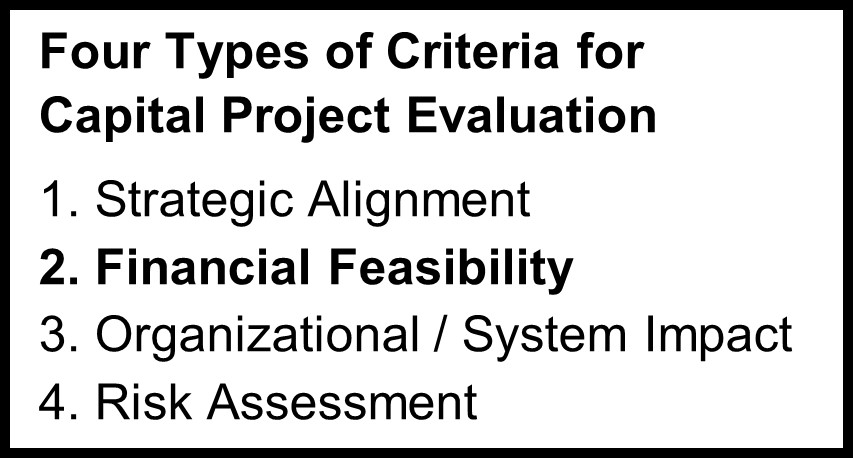Capital Part 3: Financial Feasibility
 Many organizations are working through an era of tight capital, reducing the margin for error on investment decisions to just about zero. And the current market volatility is only adding to the stress level surrounding these decisions. In this series, we describe how leadership teams can select the “best” projects to fund with limited capital from a large number of potential “game changers. The previous post introduced the first of four recommended criteria for selecting the best projects to fund. Some elements of that first criterion, Strategic Alignment, are well established, while others add new perspective to reflect where health care is heading.
Many organizations are working through an era of tight capital, reducing the margin for error on investment decisions to just about zero. And the current market volatility is only adding to the stress level surrounding these decisions. In this series, we describe how leadership teams can select the “best” projects to fund with limited capital from a large number of potential “game changers. The previous post introduced the first of four recommended criteria for selecting the best projects to fund. Some elements of that first criterion, Strategic Alignment, are well established, while others add new perspective to reflect where health care is heading.
This second criterion is also a blend, with the first two elements being well-established and four more to advance your discernment of the “best” projects.
2. Financial Feasibility: Whether familiar or not, nearly all these six elements could apply to just about any capital project, while the last one relates to “Bricks and Mortar” projects.
A. Performance on Standard Valuation Metrics: For any capital investment we recommend examining three key metrics: 1) Internal Rate of Return, 2) Payback Period and 3) Net Present Value (using a Discounted Cash Flow Model).
B. Cost Saving: For replacement projects, how do the operating costs for the proposed project compare with existing costs? Will the new project create operational efficiencies? Are the estimates accurate? Have they been considered in the valuation metrics?
C. Incremental Income: Consider the ways the project will (or won’t) generate truly new income. Moving an existing service line to a new building doesn’t necessarily bring in new revenue. What is an additive? Conversely, is there potential for new downstream revenue by increasing referrals for other needed services? For example, space used for cancer screening can lead to surgeries, chemo infusions, or radiation treatment.
D. Incremental Expenses: It is also critical to examine what new expenses will be incurred. Will a new service line require adding a new physician? Will marketing costs be incurred? Does growing a service line require additional staff, equipment or supplies. Are these readily attainable? Are the supply chains reliable?
E. Reimbursement and Inflation. Another critical consideration to be carefully examined is the impact of reimbursement. Will the project result in any changes in reimbursement (e.g. HOPD vs. ASC rates)? Relatedly, payer mix may change if the project involves a relocation, participation in a new network, or a different marketing plan. Lastly, consideration should be given to inflation which may impact the cost of materials and labor for new construction and specific line items in the operational financial projection.
F. Buildings: Bricks and mortar investments have important additional considerations:
-
- Lease? Where possible, leasing or renovating existing space should be considered in addition to building new. The growing commercial real estate glut (resulting from the trend toward remote work) has made leased space more plentiful and affordable.
- Minimize Non-Revenue Producing Space. With renovations, consider converting administrative or support space to revenue producing space. With new construction, consider if support services like finance or human resources can be maintained in a remote or partially remote capacity.
- Flexibility by Design. Design flexible space that can easily adapt to a variety of services as the market changes. For example, design office space that can be modified for primary care or wellness offerings (e.g. physical therapy, mental health counseling, or lab), to better meet consumer expectations and community needs.
Are you and your leadership team prepared to get the most out of your capital investments? Let us know if you have any additional thoughts as this series unfolds, or if we can be of any help applying these ideas in your capital project review, selection, and implementation processes.
Roberta Jelinek and Jeff Schilling
(This is the 3rd of 7 posts in the series. For the full article, contact either one of us.)

Leave a Reply
Want to join the discussion?Feel free to contribute!